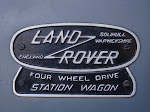Anyway, I promise that I will do better at posting......
I last left off with removing the knackered parts of the rear half shaft. I purchased the replacement parts from Atlantic British. While waiting for the parts to arrive, I decided it would be a good time to dismantle and inspect the differential and rear axle. Here are some pics.
 The differential housing.
The differential housing.The only problem encountered was that the bolt at the very top, and at the 5 O'clock position, broke and had to be replace. You can see the new bolts here. It was interesting getting the broken ones out! Other than the bolts, the only hard part was getting the diff in and out.

Here are some close-ups of the differential. As you can see, it doesn't look too bad for being 44 years old.



As some of you may know, Grover was having a hard time starting and staying running. For the life of me I couldn't figure out why this was happening. My brother (the engine Guru); father; and father-n-law couldn't figure out what was causing the engine to die most of the time either. All we knew was that it had to do with the carb.
My brother, Randy, likes carbs. He likes them to the point that tearing apart and re-building them is a hobby. So, he has taken apart, cleaned, refurbished and rebuilt Grover's carb three times! Each time it would work perfectly for about a week or so and then it would start sputtering and dying just like before.
Grover's engine is the original 2.25L that was put in back in '63. As far as I know the original carburetor would have been a Solex. After 1967, the Zenith 36IV would become the 'stock' carb for Land Rovers. So, it is assumed that sometime around '67, the Solex was replaced by the Zenith model.
Unfortunately, the Zenith carbs had a flaw that would come to be known as "Zenith Warp". Here is a description of the problem written by the talented Alan Richer.
"As we all know, the poor heat treatment and insecure design of Zenith carburetors often causes the body halves to warp and twist - leading to air leaks, poor mileage and even worse running characteristics.
The classic symptom of the warped-body problem is an inability to adjust a rich idle mixture using the mixture adjust screw on the side of the carburetor base. If the engine won't stall with the screw wound all the way in, likely it's siphoning fuel past a bad gasket and seal between the halves."
Throughout the entire carburetor ordeal the members of the Land Rover Owners Mailing List, walked me through it. Two of the members who virtually held my hand through this mess were TeriAnn Wakeman, and Alan Richer - THANKS you two! They supplied me with lots of information and tech help. If it wasn't for TeriAnn I would never of known about the "...redundant vacuum port, blocked on the top housing side, that opens when the warp occurs".
Here are some pics.




At this time I also started the process of replacing some of the other seals and gaskets such as the oil pan gasket, hub seal gaskets on the rear axle and the front & rear output seals/gaskets.
Well, till next time...
Cheers!
Larry ~










2 comments:
Hi I own an Series III 74 Petrol (Gasoline) model, it comes with a Zenit carburetor just like the one on the pictures, seldom it fails like running out of fuel, it happens on high altitudes about 3000 meters high, have you run yours that high? Could it be related to mixture and the oxygen at that altitude?
Not sure what to tell you. I've never had Grover at a high altitude.
I do know of a group you can join that would be able to answer that question.
http://oryooki.caloccia.net/mailman/listinfo/lro
Have a look at this group - they really are a great source of info.
Post a Comment